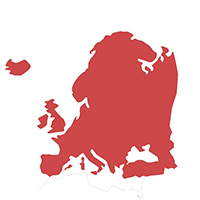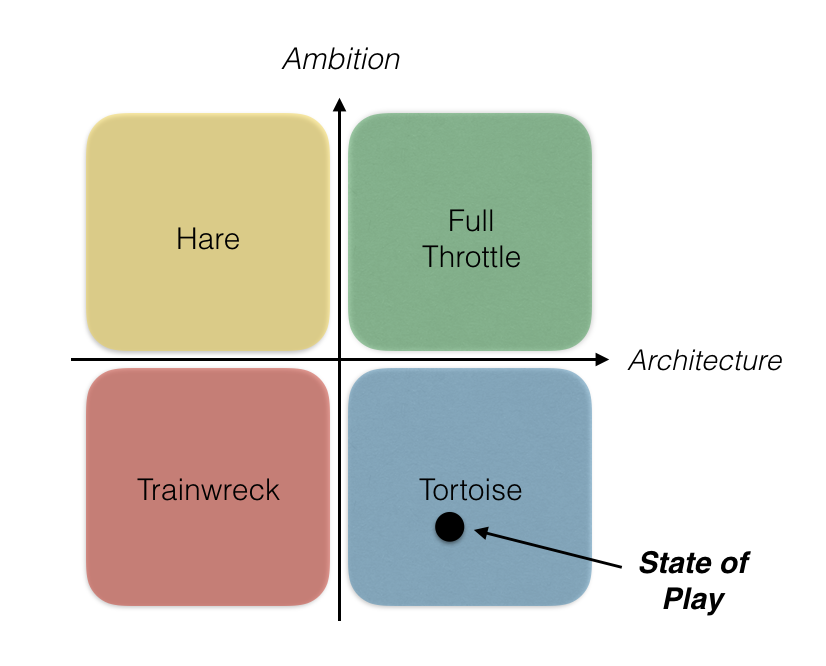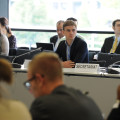State of Play: Talks Gridlocked Over Money
Hamish M | December 3, 2015.
Week one of the Paris climate talks is nearly over, and as countries clash over key issues, optimism has given way to gridlock.
The key blockers are seen to be Saudi Arabia and India on the one hand, and a cabal of developed countries including Australia, Canada and the US on the other.
The Verb’s Negotiation Compass tracks the progress of seven key issues, in terms of the ambition expressed to tackle them, and the emerging architecture that will facilitate future progress.
Here is our assessment of the current state of play:
1. Short-term mitigation
Of all the issues, this is one of the most progressed and we are tracking to a clear Tortoise scenario, with low ambition but strong architecture. Almost all countries have now announced their intended emissions reduction targets, and this is unlikely to increase during the conference. The aggregate impact of the pledged cuts is insufficient to meet the 2°C target, and tracks closer to 3°C.
Dispute centres over who must make the additional cuts needed. Australia, the USA and Canada are arguing that the developing world must commit to greater cuts, an argument swiftly shut down by India, whose energy minister declared on Dec. 3 that “we are not at all apologetic of using coal”. India has promised however to cut coal use if there is more money to help it shift to renewables, but with finance talks also stalling, mitigation ambition looks unlikely to increase.
2. Ratchet-up mechanism
There is almost universal consensus over five-year review cycles to re-evaluate countries’ pledges, though some have emphasised that this is a fragile agreement. Saudi Arabia, China and India for instance are pushing back strongly on five-year reviews as they are reluctant to commit to increasing their ambition. Start dates for these reviews are still up in the air though, and it is unclear whether the reviews will require increasing commitment, or merely serve as reviews. Currently this is in Tortoise territory, but is flirting with a Trainwreck.
3. Long-term goal
There are currently five options on the table, the strongest being an “equitable distribution of a global carbon budget based on historical responsibilities” and the weakest merely calling for “a peaking of global greenhouse as emissions as soon as possible”. A new coalition of the most vulnerable states are pushing hardest for a strong long-term goal, calling for total decarbonisation by 2050, a date India is wanting pushed back to 2100. In terms of a temperature goal, the poorest states are pushing to revise the target peak temperature down from 2°C to 1.5°C, a position supported by Germany and France, but which is likely to be knocked down by India and the oil-producing states.
4. Transparency and accountability
The negotiations on transparency are moving slowly and parties remain far apart. Differentiation remains a sticking point in the negotiations with wide ranging options reflected in the text. Tensions erupted earlier in the week when the EU and the USA proposed a single standard of reporting for all countries, but after rapid backlash, word is a compromise option is more likely, whereby a single centralised monitoring system is established to cover all parties, but which applies different standards to countries based on levels of development.
5. Finance
This is the issue defining the conference. Wednesday, the United States threw a grenade by asking developing countries to commit to financing on par with developed ones, which was seen to violate the key principle of differentiation. The G77+China responded, yesterday, by pointing out that developing nations are already using their own resources, but asking that developed countries lead the way.
Looming over the discussions is a controversial financing proposal whereby developed countries could meet their obligations through loans instead of one-off payments. The proposal has been rejected by the Africa group. A statement from donor countries clarifying progress towards their financing goals and post-2020 plans, was scheduled for yesterday but was cancelled amid the chaos
In a positive sign, late last night, the EU broke away from the group to announce its own support for post-2020 finance scale up from a $100 billion floor. In another sign of potential breakthrough, a member of the Indonesian delegation told The Verb: “If developed countries give their best, we can’t ask for more. We’re them to go from 80 to 100 per cent, and when they give us that we’ll ask for 150%. There will never be enough”.
No sign of these attitudes filtering through to the negotiations though. Currently this is in Trainwreck territory, but has potential to end up literally anywhere on the Compass. The chair of the G77 has declared that finance will “make or break” the negotiations.
6. Adaptation
Negotiations are progressing well, with half of the text having already been covered. There is one major controversy here: how much of the US$100 billion climate financing goes to adaptation. The Africa group is pushing for 50 per cent, whilst more realistically, we will end up with something closer to $32 billion. Part of this depends on whether adaptation efforts are linked to mitigation ones; if there is more mitigation, there will be less need for adaptation, but if we pollute more and warm the word more we will have to do more adapting. It’s a zero-sum game. Looking likely to be a Hare, with firm commitments to 2020, but unclear path forward.
7. Loss and damage
Though the formal negotiations for loss and damage only started last night, behind-the-scenes dealings since Sunday have lead to intense gridlock. The developed world has blankly refused the possibility of compensation, and the developing countries bloc have hit back declaring any proposal that explicitly excludes compensation is a ‘non-starter’. However, the politics of this are complex.
The case for developed world compensation is based on the fact that most historical emissions come from the developed world. But by 2030, most historical emissions will have come from the developing world, mostly from India and China. So these two states are trying to avoid any language that might lock them into future compensation. For most of the developing world, whose emissions will never get close to those levels, this is not an issue. If the developing world bloc splits between China, India and the rest, a deal on loss and damage could be in sight. The United States is emerging as the unlikely peace broker here. Currently in gridlock, and deep in Trainwreck territory.
While the possibility of a Trainwreck looms large for some parts of the negotiations and there are large challenges to be resolved before an agreement can be reached, it appears that the negotiations are trending towards a Tortoise scenario.














comment